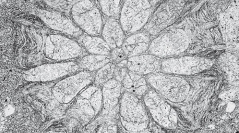

 Geodiversitas
34 (4) - Pages 693-738
Geodiversitas
34 (4) - Pages 693-738A bryozoan fauna containing 16 species is described from a set of small mud mounds occurring in the Lebanza Formation (Lower Devonian) of the Arauz area, NW Spain. One genus with one species is new: the cystoporate Petalosis clarus n. gen., n. sp. Eleven new species are described: three cystoporates Altshedata hispanica n. sp., A. gracilis n. sp. and Fistulipora arauzensis n. sp.; four trepostomes: Neotrematopora tenuis n. sp., Leioclema arauzensis n. sp., Eridotrypella validaeformis n. sp. and Leptotrypella armata n. sp.; two rhabdomesine cryptostomes Orthopora spinosa n. sp. and Vidronovella elegantula n. sp.; and two fenestrates Rectifenestella exiliformis n. sp. and Tectulipora tuberculata n. sp. Two species were identified at genus and family level respectively: Eridopora sp. and Rhomboporidae sp. indet. Two identified species show palaeobiogeographic relations to the Lower Devonian of Altai, Mongolia, and Tajikistan respectively: Leioclema multiacanthoporum Astrova in Astrova & Yaroshinskaya, 1968 and Hemitrypa lasutkiniae Waschurova, 1964. The bryozoan fauna is dominated by cystoporates and trepostomes, followed by cryptostomes and fenestrates. These species display four different growth habits: encrusting (43.75%), ramose branched/encrusting (12.5%), ramose branched (25%), and reticulate (18.75%). Encrusting and encrusting/ramose growth habits dominate in all parts of mud mounds, whereas ramose branched and reticulate bryozoans are most abundant in the lower part of mounds, being rare in the upper parts. Despite their abundance, bryozoans cannot be regarded as the principal builders of the mud mounds, which apparently were mainly built by microbial communities. Nevertheless, bryozoans played the role of sediment binders (encrusting species), stabilizing the sediment, or exerted a baffling effect (fenestrates).
Bryozoa, Lower Devonian, Spain, taxonomy, ecology, new genus, new species